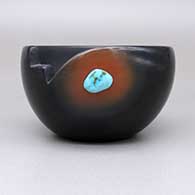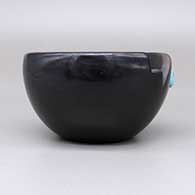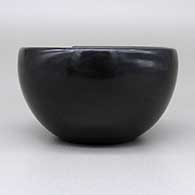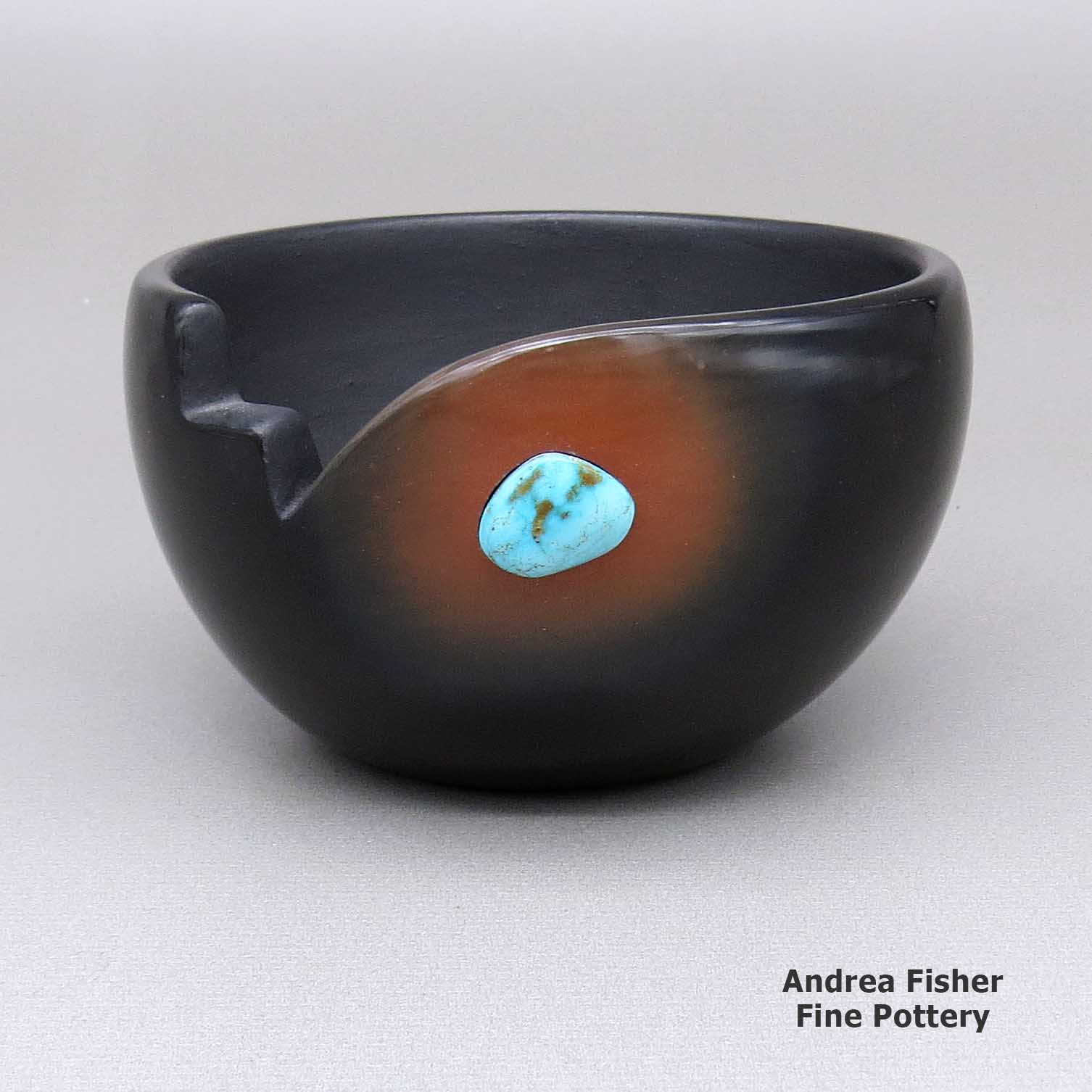
San Ildefonso
$ 1100
zzsi3h734m2
Black bowl with a asymmetrical kiva step geometric and organic cut opening, a sienna spot, and an inlaid turquoise stone detail
4.25 in L by 4 in W by 2.5 in H
Condition: Very good, sticker residue on bottom and normal wear
Signature: Dora Tse-Pe San Ildefonso
Tell me more! Buy this piece!
(505) 986-1234 - www.andreafisherpottery.com - All Rights Reserved
Dora Tse Pe
San Ildefonso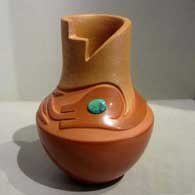
Dora Gachupin was born at Zia Pueblo in 1939 to parents Candelaria Medina of Zia and Tony Gachupin of Jemez. She married Johnnie "Tse-Pe" Gonzales of San Idelfonso when she was about 20 and contrary to the ancient tradition, moved to his home from Zia (the Pueblo people are generally matrilineal and home is usually where the wife's family resides). She had grown up learning the Zia pottery designs and shapes but at San Ildefonso, Dora was exposed to the highly polished redware and blackware that Rose Gonzales, her mother-in-law, made. "We didn't polish at Zia", Dora has said, "we used slips and plant and mineral paints." It was from Rose that she learned polishing and other San Ildefonso and San Juan styles and techniques. She said about Rose, "I love her work, and I love carving. And I love the water serpent. It depicts water - rain, thanksgiving and prayer for water. It's a San Ildefonso trademark. I like to make my serpent really simple and graceful. You'll notice that Santa Clara serpents look almost oriental, all the curves on the backs and all. Mine are very plain."
Other exceptional potters who have influenced Dora over the years include Popovi Da with his two-tone black and sienna ware and Tony Da with his use of stone inlay. Dora's work often includes turquoise or coral inlays on pots that also include combinations of black and sienna with micaceous slips. Her innovative style has sometimes been called "contemporary" and she often works with both polished clay and dull or micaceous clays in the same piece. However, she says she doesn't like that "contemporary" term and considers herself and her work to be traditional.
She earned many awards including Master Potter at Santa Fe Indian Market. Dora believes in quality not quantity and sees her art to be a gift from God. "It gives me pleasure to create beauty from the earth," she said.
Some Exhibits that featured Dora's work
- Choices and Change: American Indian Artists in the Southwest. Heard Museum North Scottsdale. Opened June 30, 2007
- Recent Acquisitions from the Herman and Claire Bloom Collection. Heard Museum. Phoenix, AZ January 11, 1997 - July 31, 1997
- Fifth Annual Hollywood Premiere. Four Seasons Hotel, Los Angeles, CA. Gallery 10. Scottsdale, AZ. November 23, 1991 - November 24, 1991
- Magic in Clay. Morrill Hall, University of Nebraska State Museum. Lincoln, NE. May 5, 1991 - August 30, 1991
- 1976 Heard Museum Guild Indian Arts and Crafts Exhibit. Heard Museum. Phoenix, Arizona. November 26 - December 5, 1976
Some Awards Dora Earned
- 2009 Heard Museum Guild Indian Fair & Market: Judge's Choice Award
- 2007 Heard Museum Guild Indian Fair & Market, Class. II - Pottery, Division B - Traditional, native clay, hand built, unpainted: First Place
- 2007 Heard Museum Guild Indian Fair & Market, Judge's Choice Award
- 1976 Heard Museum Guild Indian Arts and Crafts Exhibit, Classification X - Pottery, Division C - Figurines, bells, jewelry, miniatures, etc.: Second Place. Awarded for artwork: Miniature vase
- 1976 Heard Museum Guild Indian Arts and Crafts Exhibit, Classification X - Pottery, Division C - Figurines, bells, jewelry, miniatures, etc.: Honorable Mention. Awarded for artwork: Turtle with etched serpent
San Ildefonso Pueblo
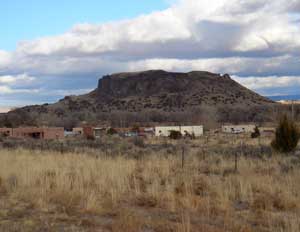
Black Mesa at San Ildefonso Pueblo
San Ildefonso Pueblo is located about twenty miles northwest of Santa Fe, New Mexico, mostly on the eastern bank of the Rio Grande. Although their ancestry has been traced to prehistoric pueblos in the Mesa Verde area, their most recent ancestral home is in the area of Bandelier National Monument, the prehistoric village of Tsankawi in particular. Tsankawi abuts the reservation on its northwest side.
A mission church was built in 1617 and named for San Ildefonso. Hence the name. Before that the village was called Powhoge, "where the water cuts through" (in Tewa). Today's pueblo was established as long ago as the 1300s. When the Spanish arrived in 1540, they estimated the village population at about 2,000.
That mission was destroyed during the Pueblo Revolt of 1680 and when Don Diego de Vargas returned to reclaim the San Ildefonso area in 1694, he found virtually all the Tewa people on top of nearby Black Mesa. After an extended siege the two sides negotiated a treaty and the people returned to their villages. However, the next 250 years were not good for them. The Spanish swine flu pandemic of 1918 reduced the pueblo's population to about 90. Their population has grown to more than 600 now but the only economic activity available on the pueblo involves creating art in one form or another. The only other work is off-pueblo. San Ildefonso's population is small compared to neighboring Santa Clara Pueblo, but the pueblo maintains its own religious traditions and ceremonial feast days.
San Ildefonso is most known for being the home of the most famous Pueblo Indian potter, Maria Martinez. Many other excellent potters from this pueblo have produced quality pottery, too, among them: Blue Corn, Tonita and Juan Roybal, Dora Tse Pe and Rose Gonzales. Of course the descendants of Maria Martinez are still important pillars of San Ildefonso's pottery tradition. Maria's influence reached far and wide, so far and wide that even Juan Quezada of the Mata Ortiz pottery renaissance in Chihuahua, Mexico, came to San Ildefonso to learn from her.
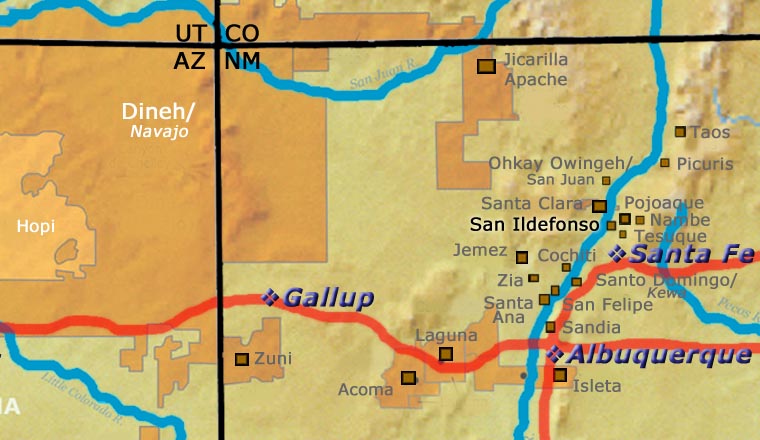
San Ildefonso Pueblo at Wikipedia
Pueblo of San Ildefonso official website
Pueblos of the Rio Grande, by Daniel Gibson
Photo is in the public domain
Gonzales Family Tree
Disclaimer: This "family tree" is a best effort on our part to determine who the potters are in this family and arrange them in a generational order. The general information available is questionable so we have tried to show each of these diagrams to living members of each family to get their input and approval, too. This diagram is subject to change should we get better info.
-
Ramona Sanchez Gonzales (1885-), second wife of Juan Gonzales (painter)
- Rose (Cata) Gonzales (daughter-in-law) (1900-1989) & Robert Gonzales (1900-1935)
- (Johnnie) Tse-Pe (Gonzales)(1940-2000) & Dora Tse-Pe (Gachupin, first wife, Zia, 1939-2022)
- Andrea Tse Pe (1975-)
- Candace Tse-Pe (1968-)
- Gerri Tse-Pe (1963-)
- Irene Tse-Pe (1961-)
- Jennifer Tse-Pe (1960-1977)
- (Johnnie) Tse-Pe (1940-2000) & Jennifer Tse Pe (Sisneros - second wife, Santa Clara)
- (Johnnie) Tse-Pe (Gonzales)(1940-2000) & Dora Tse-Pe (Gachupin, first wife, Zia, 1939-2022)
- Blue Corn (Crucita Gonzales Calabaza)(1921-1999)(step-daughter of Ramona) & Santiago Calabaza (Santo Domingo) (d. 1972)
- Joseph Calabaza (Tha Mo Thay)
- Diane Calabaza-Jenkins (Heishi Flower) (1955-)
- Elliot Calabaza
- Juanita Gonzales (1909-1988) & Louis "Wo-Peen" Gonzales (brother of Rose Gonzales husband)(1905-1992)
- Adelphia Martinez (1935-2022)
- Lorenzo Gonzales (1922-1995)(adopted by Louis & Juanita Gonzales) & Delores Naquayoma (Hopi/Winnebago)
- Jeanne M. Gonzales (1959-)
- John Gonzales (1955-)
- Laurencita Gonzales
- Linda Gonzales
- Marie Ann Gonzales
- Raymond Gonzales
- Robert Gonzales
- Oqwa Pi (Abel Sanchez)(1899-1971) & Tomasena Cata Sanchez (1903-1985)
- Skipped generation
- Russell Sanchez (1966-)
- Skipped generation
Rose' students:
Some of the above info is drawn from Pueblo Indian Pottery, 750 Artist Biographies, by Gregory Schaaf, © 2000, Center for Indigenous Arts & Studies
Other info is derived from personal contacts with family members and through interminable searches of the Internet.
Copyright © 1998-2024 by


